INTRODUCTION
The Franco-Prussian War is the one conflict most overlooked by miniature gamers. There are only 5 wargamers I know of nation wide that game in the period. That is a real shame. it is hoped that the following set of rules may help remedy this sad situation.
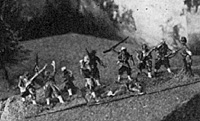 FRENCH REGIMENT IN LINE OF BATTLE
FRENCH REGIMENT IN LINE OF BATTLE
Nach Paris is first and foremost an extremely fast moving grand tactical simulation of the FrancoPrussian War of 1870-1871. This period with the widespread introduction of breechloading rifles and artillery, along with primitive machine guns revolutionized the science of war. It was the last war of ritual and glamour in uniform. These rules give an almost realistic view of the time. Cavalry in the game for example will do much better on the table top than their real life counterparts did in the field. The authors freely admit this, defending only on grounds that it makes for a better game and that well painted Uhlans and Cuirassier are simply too nifty looking to always fail.
The scale of 1 " = 100 yards makes for a grand tactical game with the possibility of commanding several corps. The entire game is built around the concept of BREAKING POINT or BP-another version of the CE of "LA GUERRE", or the CV of "ON TO RICHMOND" except in this case we take it one step further. Not only is the unit's combat power included in the quantification but its morale level, and leadership as well. For ali this the rules are simple and easy to play. It is our hope you find them as congenial a way to fight a little war as we have.
GENERAL ORGANIZATION
INFANTRY: stands are 11/2 " by 1" and represent about 600 men. It is immaterial how many miniatures are used on the stands, but three 20-25mm of five 15mm figures work out well. Each stand roughly represents a French battalion or 2/3 of a Prussian Battalion. We mount Light Infantry on a 21/2 by 1" stand but use only 3 figures. In this game they are elite marksmen of high morale and training. Our Lights then operate as independent stands whereas line units must maintain at least regimental integrity.
CAVALRY: stands are 1 1/2" square, representing about 300 sabres. Two such stands being a regiment. We mount two 20-25mm troopers per stand while 15mm figures might call for 3 or 4.
FRENCH ORGANIZATION
INFANTRY: Regiments muster 3 stands with 2 Regiments forming a Brigade. A Division is tken composed of 2 such Brigades and a Battalion of Chasseurs or Light Infantry. An Infantry Division would also include a Battalion or 2 of Artillery, about 1/4 of which would be Mitrailleuse (the French Gatling gun). For each Division a Commanding Officer figure is also added.
CAVALRY: Regiments muster 2 stands with 2 or usually 3 regiments forming a Brigade. Brigades were of the same type such as all lancers, all Hussars or all Dragoons. Two or three Brigades form a Cavalry Division, to which a battalion of Horse Guns might be attached.
Cavalry armed with carbines (usually any but Lancers and Cuirassier) may dismount and fire weapons. We replace the mounted stands with alternate dismounted stands but they might more simply be marked in some manner.
ARTILLERY: Battalions are allocated 1 or 2 to a division with 1 or 2 more kept in a Corps reserve.
A French Corps would consist of two to four Infantry Divisions with a Cavalry Division. All French Corps were at first in a single army under Bazaine or Nappy III himself (poor beggers).
PRUSSIAN ORGANIZATION
INFANTRY: Regiments boast 4 stands, with two regiments thus forming an 8 stand brigade. Two brigades and a Cavalry regiment (usually of Lt. Dragoons or Uhlans) formed an Infantry Division with a battalion or 2 of attached artillery. Two such Divisions with the additions of 2 more cavalry Regiments, a battalion of jaegers, and 2 more battalions of guns made up a Corps. Two Corps with the possibility of a Cavalry Division made up an Army.
CAVALRY: Regiments of 2 stands, with 3 regiments forming a brigade and 2 or 3 brigades forming a Division. Many Prussian Corps COs brigaded their Corps and Division Cavalry into ad hoc brigades. As with the French, Prussian jaegers are elite lights, and Cavalry may dismount if rifle armed.
ARTILLERY: While not having the Mitrailleuse, Prussian guns were the pride of the nation. They consisted of Steel Krupp Breechloaders. They were parcelled out to all Divisions as well as Corps reserves. They are more numerous than the French guns and far more deadly.
As with the French it will be necessary to add COs to each Prussian Division, Corps and Army.
ARTILLERY: stands are 11/2" square, mounting a gun model and 3 crew. We find that 2 model guns look much better for 15mm figures. Such a stand represents a battalion of around 12 guns.
BREAKING POINT (BP) & COMMAND QUALITY
NACH PARIS grades both units and leaders. BP refers to the overall battle worth of units-its loss is in morale as well as casualties as it represents combat and firepower, not mere numbers. The game charts give a chance variance reflecting the probable distribution of good and bad troops and leaders drawn from the historical conflict. Before the game each player rolls a D10 to determine the quality of commanders for each of their Divisions and for the CinC. Based on the results of the Divisional CO rolls, the quality of the troops in the various Divisions are established. The quality of the CinC affects only the initiative rolls of the movement sequence and the rebuilding rolls. The quality of both leaders and troops may be set up in advance by an umpire for specific scenario needs.
SEQUENCE OF PLAY
INITIATIVE PHASE: A D10 is cast b y each CinC altered by his "quality". Above average CinCs add 1 while Below Average subtract 1. (ALL DIE ROLLS IN NACH PARIS ARE D10S.) The CinC who rolled the high die must move first for that turn.
MOVE PHASE: The winner of the die roll now moves any or all of his units. While moving his opponent times him with a stop watch. The time taken by the first player is the exact amount of time the second player will have to move his units. The time allowed however may never be less than 1 minute. Any forces that are not moved by the end of the allowed time may not move that turn. Units which move into melee combat should be halted about 1" from their target; until after the FIRE PHASE, but their target is considered pinned and may not move on its turn.
ARTILLERY PHASE: The winner of the initiative now fires his artillery followed by his opponent's reply. Fire is considered simultaneous within the phase. Thus guns destroyed may return fire for that turn only. Other units, however, that are hit in the ARTILLERY PHASE may not fire in the FIRE PHASE. In other words, if the Prussians destroy a Mitrailleuse with their guns it is gone before it can fire. Likewise a unit that has a RUN registered against it by artillery will be classified as "running" in the FIRE PHASE.
FIRE PHASE: Small Arms and Mitrailleuse now fire as in the ARTILLERY PHASE. However, in order to fire on a unit that has already been hit, the firing unit must first roll less than its own BP. This holds true for all fire.
MELEE PHASE: In this period, this is any action inside of 100 yards. Any melees that have been joined now fight out a round. In this game some melees go on for several turns. This is to simulate either out of control cavalry or the "meat grinder" fire fights of the period.
RALLY PHASE: Units are now rallied and reserve units attempt to rebuild BP.
Return to step 1 and begin new turn.
MOVEMENT
Movement in NACH PARIS is simple, based on formation and terrain. Units may move up to the distances listed. If they cross disruptive terrain such as woods, hills, etc., they roll a D10 and adjust for the penalty as per the charts. For example, if Light Infantry rolls a 6 they would deduct 3" from their move or 1/2 the die roll. If they had been line infantry they would deduct 4" or 1/2 die roll+ 1 and so on.
Deployment cost is figured the same way. Each unit deducts the deployment cost penalty shown in the rule charts. Units may change formation either at the beginning or at the end of their movement but only once per turn. Changes of facing are free of penalty but no stand may move further than its allowed rate. We recommend a "wheelin" rule such as available from RAFM (see The Courier Dispatch -Vol V, No 2).
FIREPOWER
All fire is taken from the same chart with the sole exception of Counter Battery fire. This combat chart is simple but unique. Morale and killing power are combined into a single roll. Units "fire" varying numbers of dice and this is compared with the activity of the target unit. The roll is altered by tactical factors and then compared to the target's BP and the penalty assigned. It is all quite simple once tried. For example, let's say a battalion of Prussian jaegers fires at a French infantry regiment which is advancing toward it. No alterations apply and the Prussians roll a 7. We learn that the BP of the French is 6.
Looking at the chart shows that the Prussians have forced the French unit to fall back. infantry regiments may roll 2 dice when firing if they have not moved that turn. They then choose which die roll result they wish to use. Likewise French Mitrailleuse Batteries may roll 3 dice if they have not moved but only 2 if they have. In any case only 1 D10 counts, they simply choose which one. It should be noted that in NACH PARIS fire affects movement and only at times forces a loss of BP. A 0 rolled against a target will force it to take a full move straight forward as far as its formation and terrain, etc. will allow. If this produces a melee it will be fought out at the proper time. Units, for the sake of keeping track, usually fire from left to right. There are times therefore when an enemy unit may be "routed" by fire of a first unit and a second may wish to fire at the target since it is now in a "routed" condition. To do this, the firing unit must be within range and first roll under its own BP. If it fails, its fire is wasted for that turn.
MELEE
The melee system in NACH PARIS uses the same chart as the firing procedures. It should be remembered too that in this period, at least for infantry, we are Looking at combat at about 100 yards or less not necessarily the crossing of bayonets. Units of different sizes all fight as whole units. That is, stands do not wrap around. The only advantage being a larger unit in melee is that they receive a + 1 for each extra base they have over an opponent. For example, a Prussian Regiment (4 stands) against a French Rgt (3 stands) would melee at a +1. Likewise a French line unit against a Prussian Jaeger Battalion would be +2 (3 stands against only 1). There are times when two units may melee one. in this case the single unit's roll affects both enemy units but the two units each roll separately and choose the best die result. Charges must be made in a straight line, and charging units may not fire. The March column is not a fighting formation thus any unit forced into melee in this formation will role as if it were running. Cavalry will automatically destroy any running foe it contacts.
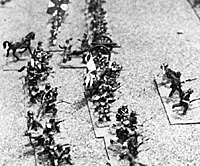 PRUSSIANS DEPLOYING INTO LINE
PRUSSIANS DEPLOYING INTO LINE
TYPES OF MELEES
FRONTAL: Attacking units move up to contact, the defender is now pinned and may not move. He may fire during the normal FIRE PHASE. Should the attacker still be in contact at the Melee phase the following procedure is used. The defender rolls first, and the results checked against the chart. Should he survive, the attacker now rolls and again results are takenthis is one round of melee. Should both sides be locked in, the melee will continue on the following turn. Neither side may move or fire until the following MELEE PHASE when another round will be fought out except that this and subsequent rounds will have both sides roll simultaneously. Remember that once locked into melee each side would be considered as HALTED or perhaps as FALLING BACK. If the melee is Cavalry vs. Cavalry then the initial round of melee is simultaneously rolled as well.
DEFENDER UNDER COVER: Same as frontal melees except the defender keeps rolling first on any subsequent rounds. Cavalry may never attack units under cover. Units under cover may ignore the "automatic advance" fire rule by rolling equal to or less than their BP.
FLANK & REAR ATTACK: In these cases an attacker rolls first and, if he survives, the defender replies. Subsequent rounds are considered as frontal and rolled simultaneously.
Cavalry will automatically pursue a defeated foe unless controlled by their commanders. If controlled it may then choose whether to pursue or rally in place. The roll to control varies with CO quality as follows:
- Below Avergae CO or None 0-1 to control
Average CO 0-2 to control
Above Average CO 0-3 to control
There is no depth of stands in these melees either, only stands in contact may join a melee. A final note:
Due to the phase system used in the game the side which moves second may reinforce a melee. That is, Side A attacks a Side B unit frontally, then on its turn Side B brings a second unit up to attack Side A's unit in flank. The procedure for melee would be first the flanking unit rolls then the frontal defender and then the attacker and so forth.
MORALE AND RALLIES
Morale for the most part is considered as part of a unit's BP, but there are times when units must be rallied. If a unit is forced to RUN on the combat chart a CO figure must move up to it to rally it. This is automatic but it counts as the move of the rallying unit for the following turn. Units, however, that ROUT during combat are somewhat more chancy. The divisional CO must roll under the unit's current BP or it will be removed from play. If this roll succeeds, 1 additional BP is restored to the unit and it may return to the fray. Above Average COs subtract 1 from their rolls while Below Average Commanders must add 1 to their rolls.
REBUILDING UNITS
Units may be withdrawn from combat and once out of range and at rest, may attempt to rebuild lost BP up to their original level during the RALLY PHASE. The roll is affected only by the quality of the CinC. A D10 is rolled and compared with the Rebuilding Table.
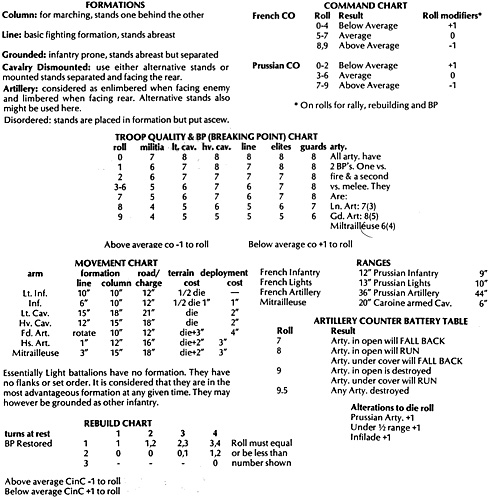
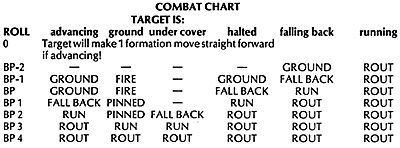
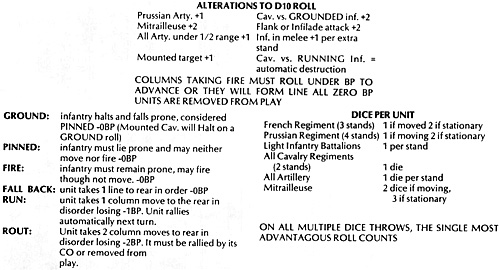
Back to Table of Contents -- Courier Vol. V #6
To Courier List of Issues
To MagWeb Master Magazine List
© Copyright 1984 by The Courier Publishing Company.
This article appears in MagWeb (Magazine Web) on the Internet World Wide Web.
Other military history articles and gaming articles are available at http://www.magweb.com